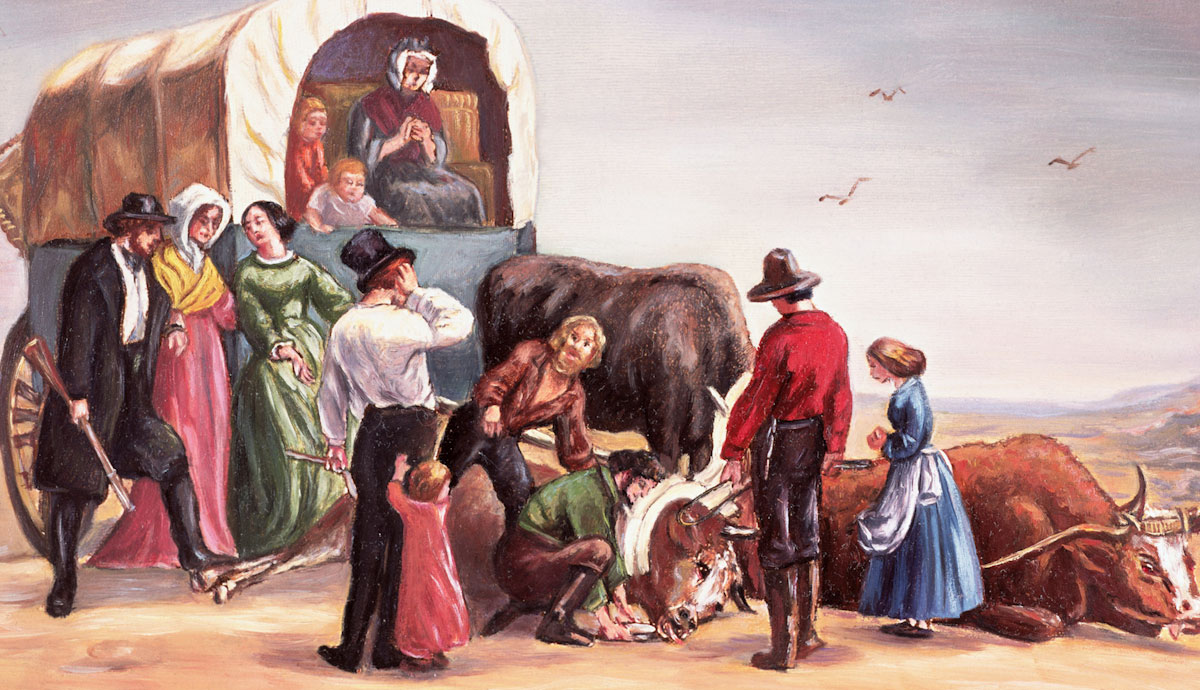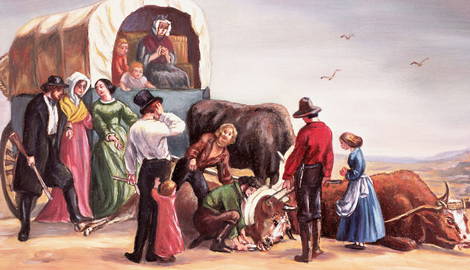
The westward migration of the American people during the nineteenth century is often memorialized in exciting stories of achievement and hope for a brighter future. However, not every voyage across the country’s interior had a happy ending. One of the most enduring and shocking examples of this journey gone horribly wrong is consecrated in the story of the Donner Party.
Donner Party: The Cast of Characters

Although they are referred to as the Donner Party, the group of pioneers involved in this tragedy comprised many families, not just the Donner relations. Eighty-seven individuals made up the wagon train that began in Springfield, Illinois in April 1846. George Donner and his brother Jacob made up the family nucleus for which the group was named, along with their wives Tamsen and Elizabeth and their children. The Donner men led the group along with Jacob Reed, who joined the party with his wife Margaret, her mother Sarah, and their children.
The Donners made a living as farmers, while Mr. Reed prospered as a contractor and builder of furniture. Both families were believers in the idea of Manifest Destiny and were drawn to the excitement and wealth “new” lands in the west offered. Several other families and individuals joined the party, including the Breens, the Eddys, the McCutcheons, and the Keesbergs.
Several families had employees who came along for the trip, and a few individual travelers paid to accompany the group. Twenty wagons in all made up the Donner Party convoy. Their destination, like many cross-country travelers of the era, was California. By June, they had reached Wyoming Territory, a crossroads for the next leg of their journey.
Hastings Cutoff, or, The Big Mistake

At Fort Bridger, Wyoming, the party had a choice to make. They could continue on the well-traveled route to California or gamble on a new route they had recently read about in a freshly-minted guidebook published by a man named Lansford Hastings. They actually met Hastings in their travels and listened eagerly as he talked about the 300 miles that his shortcut, known as the Hastings Cutoff, would save them on their journey.

Little did the Donner Party know, Hastings had never actually made the trip himself. They then met an acquaintance who warned them against taking the route. However, the group was growing worried as they were running behind schedule. They had left later in the season than was ideal and were now in a pinch to make it across the Sierra Nevada mountains before the first snows fell. Despite the warning, the Donner brothers and Jacob Reed decided that taking the Hastings Cutoff would be the best plan of attack for their wagon train. In fact, a few more wagons joined their caravan before they headed out.
The first few days of travel weren’t too challenging for the group, but they soon found themselves immersed in the Great Salt Desert. The Donners and Reeds, in particular, discovered that they had overpacked their wagons with luxury goods, and their oxen were having a challenging time moving through the heavy loads through the sand. They began offloading their possessions as they traveled through the desert and combining oxen teams to make the wagons more mobile.
The Traveling Group Grows Smaller

Tensions grew among the group members as the natural environment and the stresses of their trip began to take a toll. There were concerns that they were running low on food, and winter was closing in fast. It wouldn’t take long before the group of travelers began to shrink in size. The first loss was Jacob Reed’s mother-in-law, Sarah, who died early in the journey, only 17 days after the group left. Though she would be the first to pass away, she would be far from the last.

Death wouldn’t be the only factor that decreased the size of the group. In October 1846, Jacob Reed got into a disagreement with one of the teamsters, John Snyder, about his treatment of the oxen. Snyder was beating the oxen team owned by the Graves family, which had gotten entangled with Reed’s oxen team. When he refused to stop, Reed attempted to physically stop him and was hit with Snyder’s bullwhip. A physical altercation ensued, with Reed’s wife Margaret entering the fray and getting struck with the whip as well. Reed was driven to pull his knife and stab Snyder, an action that resulted in his death. Some group members wanted to string Reed up, while others felt his actions were justified. The following discussion determined that Reed would be evicted from the wagon train and forced to follow the trail to California on his own. He was given basic supplies and his horse and had to leave his wife and children behind.
Just a few days later, an elderly Belgian immigrant, Hardcoop, was turned out of his host’s wagon to try and lighten the load. He had been traveling with the Keseberg family on the journey, but Mr. Keseberg was concerned that his wagon was too heavy and forced the older man out. Hardcoop walked as long as he could but was soon unable to keep up. He soon collapsed at the side of the trail and was left behind. He never made it to the evening camp, and when a few volunteers went back to look for him the next day, they could not find him. He was never seen again.
Trapped in the Mountains

In late October, the Donner Party reached Truckee Lake in eastern California, just over the Nevada border. However, their greatest challenge lay just ahead: crossing the rugged Sierra Nevada mountain range. They began their slow ascent, watching with trepidation as snowflakes swirled in the air, reminding them that winter hovered in the not-too-distant future. When the group was about three miles from the summit, they found themselves face-to-face with five-foot snow drifts, directly in their path, with no clear way around them. They were forced to turn around and return to the base of the mountain. They found an abandoned cabin at the base of the mountain and decided to hunker down there in the interim. Several of the families moved into the cabin, while others built lean-tos against its sides. Others built primitive shelters and began construction on a log cabin.

Food was very short in the camp. The remaining animals in the group’s possession were oxen, cattle, horses, and even pets. The attempts by some members of the Donner party to hunt animals such as deer were unsuccessful, though William Eddy did manage to kill a bear at one point. Fishing efforts were in vain. Realizing they were running out of options, the group decided that they needed to try another approach. They decided that a small company would strike out to go and find help.
A group of thirteen men and two women left the camp on November 12th to try and reach Sutter’s Fort. After just a few days, they turned back, deterred by ten-foot snow drifts. Not long after, they set out again only to return, defeated once more. By this time, members of the camp had started to pass away from starvation and illness, and on December 16th, a final group left the camp, determined to get help. The party of seventeen was nicknamed “The Forlorn Hope.”
On the first day, two travelers turned back while the others continued to struggle through eleven-foot snow drifts and a ferocious winter storm, some with homemade snowshoes, some without. On December 21st, the group was forced to leave behind one of its members, Charles Stanton, who was dying from malnutrition and had become snowblind. By December 27th, four more members of the rescue group had died, including the youngest, twelve-year-old Lemuel Murphy. Most of the party resorted to eating the bodies of their departed compatriots, though William Eddy and two Miwok men, Luis and Salvador, refused to partake in the meals. The death toll soon rose to six.

Not long after, one member of the Forlorn Hope, William Foster, proposed murdering Luis and Salvador to provide more food for the rest of the group since they were viewed as “outsiders.” Eddy warned the two men, and they snuck away in the night. Despite this, Foster caught up with them and killed them. This led to a split into two groups, one led by Eddy and one led by Foster.
Back at the base camp, conditions for the rest of the Donner Party were not much better. Families had resorted to boiling strips of ox hide, catching mice, and eventually cannibalism of those who had passed.
Survival and Aftermath

Eddy’s party eventually made it to Sutter’s fort with the help of a Paiute guide they encountered. They found that James Reed had made it safely there three weeks after he left them in the desert. Anxious to save his family and the others, Reed and others at the fort quickly organized a rescue party. They found the rest of the Forlorn Hope group and brought them to the fort, then set out on a second expedition to the base camp. When the rescuers arrived, they found that many had died of starvation, including Jacob Donner. Those strong enough to survive were guided out by rescuers, and those who were too weak to make the journey were given supplies and a promise that another trip would be made.
After multiple trips, the final person to be removed from the base camp was Lewis Keseberg, delirious and ailing. In all, forty-two people died on the Donner Party’s doomed journey across the western United States. In analyzing the demographics of the dead, women were more likely to survive than men, and the very young and old were more likely to succumb.
The Legend Lives on, But Does the Truth?

The story of the Donner Party is one that is both heartbreaking and shocking. But what is perhaps most troublesome about the tale is the fact that it was so preventable. A series of poor decisions, compounded by clashing personalities and simple bad luck, led to the deaths of forty-two and the enduring trauma of dozens more. Often, when people hear “Donner Party,” they think “cannibals!” but the true story is so much more complex. Remembering and reflecting on the nuances and details of the story behind this tragedy helps us to appreciate and honor the true experiences of those who came before.









